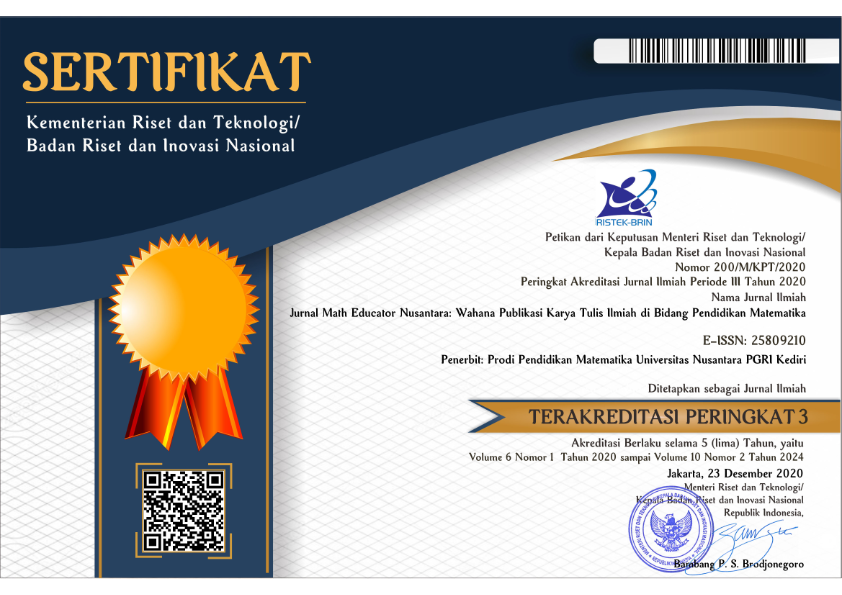Three zone learning concepts to improve mathematical proof of probability theory
DOI:
https://doi.org/10.29407/jmen.v8i1.17004Keywords:
Three Zone Learning, Mathematical Proof, Probability TheoryAbstract
This study aims to comprehensively analyze the improvement of students ' mathematical development ability through the concept of three zone learning, with the type of research is quantitative and quasi experiment design. Examples of research as many as two classes amounted to 82 pre service teacher. Data analysis by calculating gain normalization. Results: based on the Post Hoc test, the level of the category that has a positive score of 0.012 with the upper category and the middle category means that the average score of students from the upper category is better than the middle category, then also for the level that has a positive score of 0.028 with the upper category and the lower category which means that the average score of students from the upper category is better than the lower category. As for the positive value of 0.016 with the middle category and the lower category means the average of the middle category is better. From the results showed that for levels with upper, middle and lower categories, the effect is greater in improving students.
References
Education Annual Conference (pp. 350-361). Australasian Society for Computers in Learning in Tertiary Education.
Hendriana, H., Rohaeti, E. E., & Sumarmo, U. (2017). Hard Skill and Soft Skill Mathematic Student. Bandung: Refika Aditama.
Herizal (2020). Factors Affecting Mathematical Proving Ability. VYGOTSKY. Journal of Mathematics and Mathematics Education, 2(1), 33-42. DOI: https://doi.org/10.30736/vj.v2i1.187.
Hodiyanto & Susiaty (2018). Improving Mathematical Proving Ability through Problem Posing Learning Model. MaPan: Journal of Mathematics and Learning, 6(1), 128-137.
Hussain, M. A., Monaghan, J., & Threlfall, J. (2011). Extending Valsiner’s zone theory to theorise student-teacher development. Proceedings of the Brifish Society for Research into Learning Mathemafics, 31(1), 1-6.
Hussain, M. A., Monaghan, J., & Threlfall, J. (2011, 11 March). Extending Valsiner’s Zone Theory to Theorise Student-Teacher Development. Proceedings of the British Scociety for Research into Learning Mathematics. Institute of Education, London.
Iffah, J. D. N., Sutawidjaja, A., & Saâ, C. (2017). Using Valsiners zone theory for identifying the forms of students pseudo responses in mathematics teaching process. Educational Research and Reviews, 12(15), 744-753. doi:10.5897/err2016.3098.
Jacobs, B., & Usher, A. (2018). Proximity as a window into the zone of proximal development. Literacy Information and Computer Education Journal, 9(1), 2856-2863.
Kartika, E. D., & Yazidah, N. I. (2019). Analisis Kemampuan Pembuktian Matematis Pada Matakuliah Analisis Real Berdasarkan Adversity Quotient. Prima: Jurnal Pendidikan Matematika, 3(2), 152-157. DOI: http://dx.doi.org/10.31000/prima.v3i2.1385
Merrilyn and Anne. (2019). A Zone Theory analysis of identity formation in mathematics teacher education. In Elevent Congress of the European Society for Research in Mathematics Education, Utrecht University, Utrech, Netherlands.
Mubarok, M. S., Pujiastuti, E., & Suparsih, H. (2018, February). Meningkatkan kemampuan pembuktian matematis dan rasa ingin tahu siswa kelas XI MIPA SMA Negeri 6 Semarang melalui model PBL. In PRISMA, Prosiding Seminar Nasional Matematika (Vol. 1, pp. 677-683). https://journal.unnes.ac.id/sju/index.php/prisma/article/view/20217
Nurrahmah, A., & Karim, A. (2018). Analisis kemampuan pembuktian matematis pada matakuliah teori bilangan. JURNAL e-DuMath, 4(2), 21-29. DOI: https://doi.org/10.52657/je.v4i2.753
Patahuddin, S. M. (2010). Model pengembangan profesi guru secara otentik. Simposium Nasional Penelitian dan Inovasi Pendidikan. Universitas Negeri Surabaya. http://www.academia.edu.
Quaicoe, J. S., & Pata, K. (2015, November). Modelling factors influencing digital readiness: A case of teachers in Ghana’s basic school system. In International Conference on Web-Based Learning (pp. 271-277). Springer, Cham. doi:10.1007/978-3-319-25515-6_27.
Rahardi, R. (2011, 21-23 July). Valsiner’s Zone Theory As The Teachers’ Zone Of Proximal Development. In International Seminar and the Fourth National Conference on Mathematics Education (pp. 978-979). Yogyakarta State University, Indonesia. https://eprints.uny.ac.id/916/1/P%20-%203.pdf
Rocha, H. (2019). Mathematical proof: from mathematics to school mathematics. Philosophical Transactions of the Royal Society A, 377(2140), 20180045.
Santosa. (2013, 18 Mei). Menggunakan Teori Zona Valsiner Untuk Meningkatkan Kemampuan Aktual Siswa Pada Pembelajaran Matematika di Kelas. Prosiding Seminar Nasional Penelitian, Pendidikan dan Penerapan MIPA. Universitas Negeri Yogyakarta, Indonesia.
Shabani, K. (2012). Teacher’s Professional Development from Vygotsky Optique. Advances in Language and Literacy Studies. 3(2), 101–120. doi: 10.7575/aiac.alls.v.3n.2p.101.
Shokouhi, M and Shakouri, N. (2015). Towards a Stage of Proximity. Academic Research Journal, 3(2), 60–63. doi: 10.14662/IJELC2015.006.
Zulkardi, Z., Kasmansyah, K., Arif, R. I., Riswan, J., Syuhendri, S., Zainal, N., Huzaifah ... & Indaryanti, I. (2011). Model peningkatan mutu pendidikan SMA di Kota Prabumulih, Kabupaten Ogan Ilir, dan Kabupaten Ogan Komering Ilir. [Online]. Tersedia: http://repository.unsri.ac.id/id/eprint/6317
Downloads
Published
Issue
Section
License
Authors who publish with this journal agree to the following terms:
- Copyright on any article is retained by the author(s).
- The author grants the journal, the right of first publication with the work simultaneously licensed under a Creative Commons Attribution License that allows others to share the work with an acknowledgment of the work’s authorship and initial publication in this journal.
- Authors are able to enter into separate, additional contractual arrangements for the non-exclusive distribution of the journal’s published version of the work (e.g., post it to an institutional repository or publish it in a book), with an acknowledgment of its initial publication in this journal.
- Authors are permitted and encouraged to post their work online (e.g., in institutional repositories or on their website) prior to and during the submission process, as it can lead to productive exchanges, as well as earlier and greater citation of published work.
- The article and any associated published material is distributed under the Creative Commons Attribution-ShareAlike 4.0 International License
















